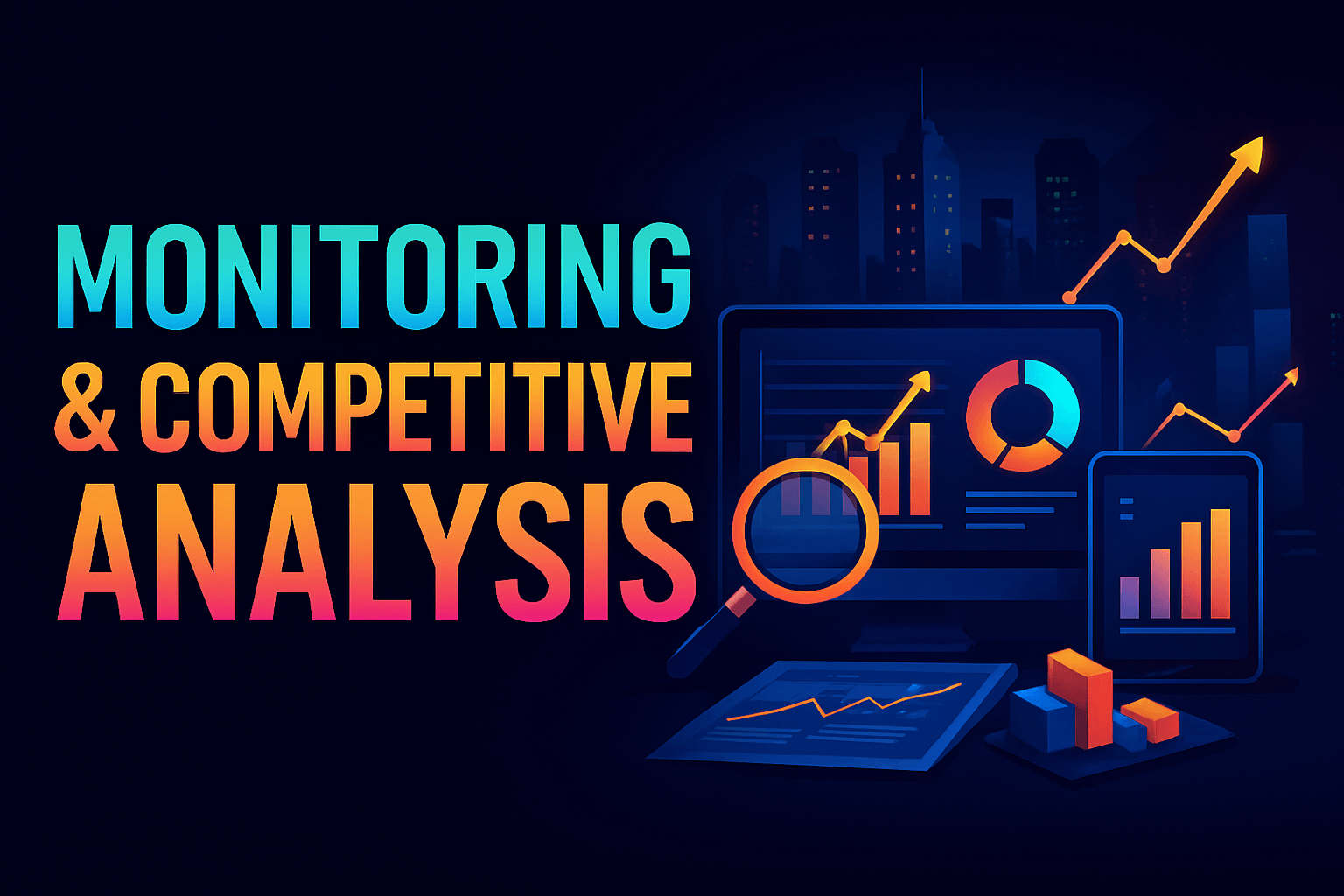How to Master Entertainment Industry Trend Monitoring & Competitive Analysis

Introduction
Navigating the modern entertainment landscape is a high-stakes endeavor. For executives, the difference between a successful investment and a costly misstep often hinges on one capability: the ability to foresee market shifts and understand a competitor’s next move.
This isn’t about guesswork; it’s about a systematic, data-driven approach to entertainment industry trend monitoring competitive analysis.
In a market defined by rapid digital transformation, fragmented data, and fierce competition for audience attention and content rights, relying on intuition is no longer a viable strategy.
The need for real-time intelligence on global projects, studio pipelines, and emerging genres is no longer a luxury—it’s a foundational requirement for survival.
This guide will provide a strategic framework for mastering these critical functions, revealing how a holistic approach can uncover new opportunities and fortify your position in the global entertainment supply chain.
Table of content
Key Takeaways
| Core Challenge | Fragmented data makes it impossible to track trends and competitor projects with the speed and accuracy required for executive-level decisions. |
| Strategic Solution | Implement a centralized, AI-powered market intelligence platform that delivers real-time data and contextual insights on the global entertainment supply chain. |
| Vitrina’s Role | Vitrina’s platform provides the single source of truth for tracking film and TV projects, companies, and collaborations from development through release. |
The Challenge of Trend Monitoring & Competitive Analysis
The traditional methods of market intelligence—relying on static reports, industry conferences, and personal networks—are no longer sufficient. The volume of content being produced and the speed at which the market shifts have created a significant gap between the data executives need and the information they can access.
This is the pain point for any senior professional tasked with content acquisition, distribution, or financing. They operate in a zero-sum environment where early access to information on a hot new project or an emerging genre can mean the difference between winning and losing.
Consider the complexity of the global media and entertainment supply chain. A single project, from ideation to final delivery, involves dozens of companies and hundreds of key decision-makers across multiple countries.
Without a unified system, monitoring these movements becomes a monumental task. The result is a fragmented view of the market, where critical insights are siloed across disparate sources, from news articles to internal spreadsheets.
This inefficiency leads to missed opportunities, suboptimal investment decisions, and a constant struggle to stay one step ahead of a rival.
According to research from Allied Market Research, the global online entertainment market is projected to reach over $1.5 trillion by 2035, indicating the scale and speed of this market and the imperative for real-time intelligence.
How to Master Entertainment Industry Trend Monitoring
Mastering entertainment industry trend monitoring competitive analysis requires a shift from reactive to proactive intelligence. This strategic transition involves moving beyond surface-level information to track the tangible movements of the industry itself.
I recommend a three-pillar framework:
- Macro-Trend Tracking: This involves identifying broad market shifts, such as the rise of Free Ad-Supported Streaming Television (FAST) services, the convergence of social media and entertainment, or the increasing use of AI in production. Tier 1 sources like Deloitte and PwC provide high-level outlooks that are essential for strategic planning.
- Micro-Trend Discovery: This is where competitive analysis becomes granular. A trend isn’t just a broad concept; it’s a measurable pattern of activity. For example, a micro-trend could be the sudden increase in live-action anime adaptations from studios in specific regions, or a spike in co-productions between companies in Latin America and Europe. This level of detail provides actionable intelligence.
- Real-Time Project & People Tracking: This is the most crucial pillar. Trends are born from new projects and collaborations. To truly anticipate the market, you must have a live feed of who is developing what, with whom, and at what stage. This provides the “early warning” system that empowers executives to act decisively, whether that means a preemptive content acquisition, a strategic partnership, or a targeted sales outreach.
The Competitive Analysis Blueprint for Executives
An effective competitive analysis strategy goes beyond simply knowing what your rivals are doing. It’s about mapping their entire pipeline and understanding their strategic direction.
Here is a blueprint for implementing this at an executive level:
- Define Your Competitive Set: Your competitive landscape is not just direct rivals. It includes studios, streamers, distributors, and even emerging digital platforms that compete for audience time and content rights.
- Map Their Projects: The most powerful competitive insight comes from tracking your rivals’ project pipelines. This includes projects in development, pre-production, and post-production. Understanding their genre focus, budget scale, and key collaborators provides a clear picture of their future content strategy.
- Analyze Their Partnerships: No one operates in a vacuum. A key part of entertainment industry trend monitoring competitive analysis is analyzing who your competitors are working with. Are they partnering with the same VFX houses? Are they acquiring content from the same distributors? This reveals strategic alliances and potential gaps in the market.
- Identify the Talent: A studio’s strategy is often reflected in the talent they engage. Monitoring which producers, directors, and writers are being attached to new projects can signal a shift in focus toward a specific genre or market.
- Benchmark Against the Market: Context is everything. Your competitive intelligence must be benchmarked against the broader market. A single platform that aggregates all this data—from studio pipelines to vendor credits—is essential to build a comprehensive view.
By combining trend monitoring with a robust competitive analysis blueprint, executives can move beyond guesswork and make truly informed, data-driven decisions that will directly impact their bottom line.
Vitrina’s Role in Market Intelligence
This is precisely the problem Vitrina was built to solve. Vitrina is a market intelligence platform designed to track the entire global entertainment supply chain. It provides a centralized, real-time solution for the very challenges of entertainment industry trend monitoring competitive analysis that we have discussed.
Unlike traditional, fragmented databases or static reports, Vitrina’s core capability is its ability to map the relationships between over 3.5 million companies and projects, updated daily.
This provides a single source of truth for industry intelligence, empowering professionals to:
- Discover Projects Early: Find new film and TV projects in their earliest stages of development and production. This is the first step in identifying emerging genres, formats, or regional trends.
- Track Studio & Streamer Pipelines: Monitor the content strategies of every major player in the market by seeing what they have in production and with whom they are collaborating. This provides a real-time view of your competitive landscape.
- Find Verified Partners: Identify and connect with pre-vetted co-production partners, distributors, and service vendors based on their credits, track record, and past collaborations.
Vitrina functions as an AI-powered strategic briefing tool for executives. It removes the need for manual research and disparate data sources by linking people, projects, and companies in one place. By doing so, it provides a comprehensive, holistic view of the global industry that is otherwise impossible to obtain.
How Vitrina Helps: Tracking the Supply Chain from End to End
Vitrina’s approach to trend monitoring and competitive analysis is rooted in its proprietary data model, which tracks the real-world flow of the entertainment supply chain.
- For Content Acquisition & Distribution: Vitrina’s Film+TV Projects Tracker provides an early warning system on upcoming content. Executives can filter by genre, territory, budget, and more to discover content for pre-buys or to find distribution partners for their finished projects. This solves the core problem of finding the right content at the right time. For example, a distributor can use Vitrina to find all new sci-fi features with a budget between $5M-$20M originating from European studios, a specific and often overlooked niche.
- For Vendors (e.g., Post, VFX, Localization): The platform transforms the business development process by allowing vendors to track projects that will soon require their services. A VFX studio can monitor all projects entering post-production, while a localization firm can track titles in the final stages of a festival run. This proactive capability turns fragmented news into a actionable business development pipeline.
- For Production & Financing Executives: Vitrina maps every key collaborator on a project, from financiers to production companies. This allows executives to quickly identify and vet potential co-production partners based on their past work, financial backing, and genre expertise. It streamlines a process that has historically been reliant on personal introductions and fragmented data. The fragmented entertainment supply chain is a pain point for the entire industry, and Vitrina’s solution is built directly to address it.
By linking projects, companies, and people through AI-driven insights, Vitrina provides a data-driven decision-making platform for a market that has long been reliant on anecdotal information and personal networks.
It is the tool for executives who need to master entertainment industry trend monitoring competitive analysis to secure their company’s future.
Conclusion
The ability to perform effective entertainment industry trend monitoring competitive analysis is no longer a strategic advantage; it is a fundamental requirement.
The global entertainment market is expanding at an unprecedented rate, fueled by new technologies, evolving consumer habits, and a constant influx of content.
For executives, the challenge is not just staying informed, but having access to real-time, actionable intelligence that reveals new opportunities and identifies competitive threats before they materialize.
A modern, proactive approach demands a platform that can connect the dots across a fragmented global supply chain. It requires a system that can track projects from ideation to release and reveal the hidden relationships between the companies and people driving the industry forward.
By adopting such a solution, you move from a reactive position of simply observing the market to a proactive one of shaping your strategic destiny. This is the new standard for success.
Frequently Asked Questions
The primary purpose is to gain a strategic advantage by understanding the content, partnerships, and future direction of rivals. This intelligence allows executives to identify market gaps, anticipate threats, and make more informed decisions on content acquisition, financing, and business development.
The biggest challenges include the sheer volume of content, the global fragmentation of data, and the speed at which the market moves. Relying on manual research and static reports makes it difficult to get real-time, comprehensive intelligence on project pipelines and emerging genres.
AI significantly impacts trend monitoring by automating the collection and analysis of vast datasets. It can track and map relationships between projects, companies, and people, providing real-time insights that would be impossible for a human to synthesize manually.
Professionals can find new opportunities by using a market intelligence platform that tracks the global entertainment supply chain. This allows them to identify and connect with new projects in development, find collaborators for co-productions, and discover new clients based on their project history and needs.

























